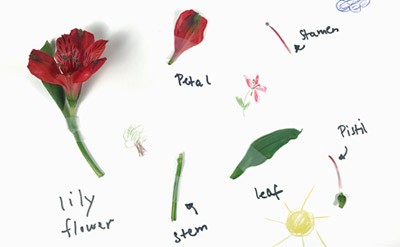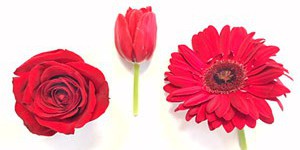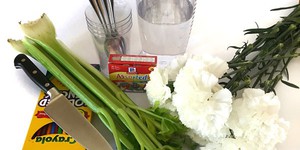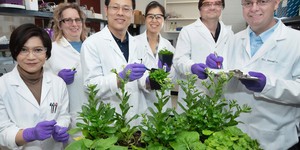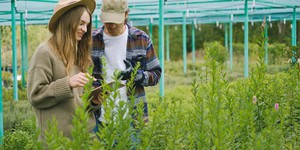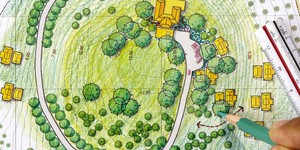Summary
Introduction
Springtime is when nature comes back to life. Trees are growing their leaves again and flowers are sprouting, displaying their beautiful colors and spreading their delightful smell. But have you ever looked at a flower in more detail? What parts do flowers consist of? Are all flowers alike? In this activity, you will find out by dissecting, or taking apart, a flower piece by piece. How many plant parts do you think you can identify?
Materials
- Fresh flowering plants with large plant parts, such as roses, tulips, lilies, petunias, carnations, or irises (Three different flowering plants, 2 of each). Note: Make sure you select perfect flowers with male (stamen) and female (pistil) plant parts. If you have allergies to certain plants, make sure that you use an alternative.
- Glass or cup with water
- Paper plates (6)
- Tweezers
- Scissors
- Magnifying glass or hand lens (optional)
- Paper (optional)
- Colored pencils (optional)
- Tape (optional)
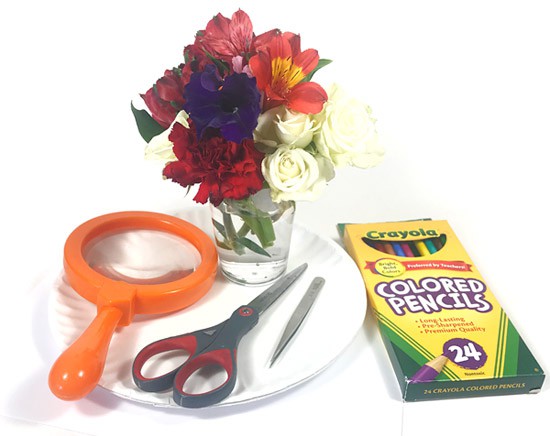 Image Credit: Svenja Lohner, Science Buddies / Science Buddies
Image Credit: Svenja Lohner, Science Buddies / Science Buddies
Prep Work
- Label each of the paper plates with one plant part (Stem, Petal, Leaf, Pistil, and Stamen).
- Label one extra paper plate "Other".
- Draw lines onto each paper plate to divide it into three sections.
- Label each section on each plate with a name of one of the three flowering plants.
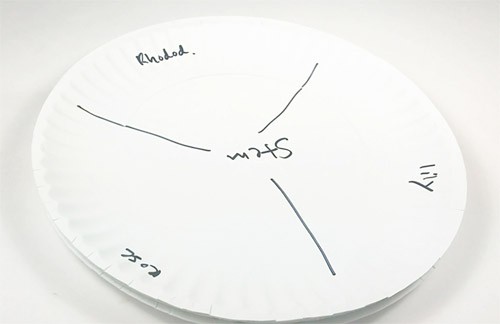 Image Credit: Svenja Lohner, Science Buddies / Science Buddies
Image Credit: Svenja Lohner, Science Buddies / Science Buddies
Instructions
- Carefully look at each of the flowering plants. If you have a magnifying glass, you can use it to examine your plants and their flowers.
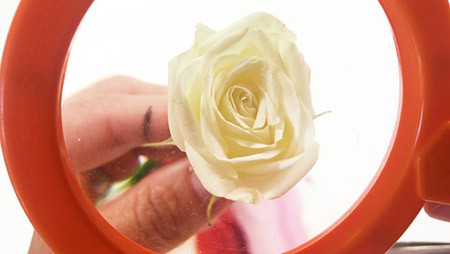 Image Credit: Svenja Lohner, Science Buddies / Science Buddies
Image Credit: Svenja Lohner, Science Buddies / Science Buddies
- Choose one of your flowering plants and start your plant dissection. Use your hands, scissors, or tweezers and carefully take apart your plant.Can you already identify some of the plant parts?
- Once you have removed one part of the plant, try to identify it, and place it on the corresponding plate. Put it in the section that is labeled with the right plant name.
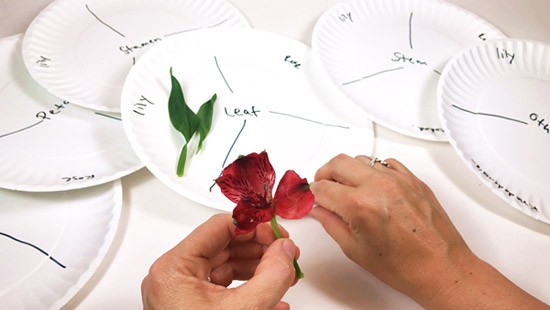 Image Credit: Svenja Lohner, Science Buddies / Science Buddies
Image Credit: Svenja Lohner, Science Buddies / Science Buddies
- If you cannot identify a specific plant part, place it on the "Other" plate.
- When you have finished taking the first plant apart, look at all its different parts.How do different parts within one plant compare?
- Next, repeat the dissection with the remaining two flowering plants. Then compare the plant parts on each paper plate.What do you notice about the same plant part from different flowering plants?
- Finally, take a look at all the plant parts that you placed on the "Other" plate. What do you think these plant parts are? How can you find out?
Cleanup
What Happened?
Just from looking at your flowering plants, you might have noticed that each looks quite different. Obvious differences, for example, are the size or color of a flower. However, when you dissected the plants, you should have been able to identify the same plant parts for each of your plants. Each of them should have had a stem, which might have had some green leaves on it; colorful flower petals; the female flower part (pistil) at the center of the flower; and the male plant parts (stamen) that produce the pollen. When you compare each plant part, you noticed that they all look very different. For example, a petal looks very different from the stem. This is because each plant part has a specific function, and its appearance is optimized to fulfill that function.
If you compare the same plant parts between different flowers, you might have observed that they look more similar. They might not have looked exactly the same, but you should have seen that they have the same functional features. For example, although flower petals can differ in size and color, they are all brightly colored or shaped in a special way to attract pollinators such as bees or other insects. The differences between different flowering plants allow us to identify different plant species. Luckily, each plant species evolved to look a little different—otherwise all flowers would look the same, and spring wouldn't be as colorful!
Digging Deeper
Not all plants make flowers; those that do are called flowering plants. But do flowers only exist to make plants look pretty? Not quite! Although they also look pretty, flowers are made for reproduction, which means they help make more plants by growing seeds. If you look closely at a flower, you might see that it is made of many different parts, each with a specific purpose.
Some flowering plants have a stem, which is a long stalk that carries and supports the flower. Leaves are of great importance as they produce the food for the plant by photosynthesis, a process that makes plant food from light, carbon dioxide in the air, and water.
When you look at the flower of a flowering plant, the most obvious parts are probably the flower petals. They can vary in size and shape, but are usually brightly colored. Their purpose is to attract insects that help to pollinate the flower. You might be surprised to learn that some flowers—in the botanical world they are called perfect flowers—have male and female parts, and each plays an important role during pollination. The male parts, called stamens, look like long stalks with a little round shape at their tip. They consist of a slender filament and a ball-shaped anther, which contains the plant pollen. This bright yellow or orange dust is what insects such as bees or flies carry from one plant to another when they are looking for nectar inside a flower.
Pollination occurs if the pollen gets carried to the female parts of a new flower, called the pistil. The pistil is usually a long stalk located in the center of the flower, and is also made up of several parts. Most importantly, it contains the ovary at its bottom, which houses the female plant eggs called ovules. When pollen is dropped into the pistil of a new flower, the eggs, or ovules, inside the plant ovaries are fertilized. The fertilized ovules then grow into plant seeds and the ovary becomes the fruit. As you can see, a flower is much more than just a pretty sight: it is essential for a plant to create its offspring!
Ask an Expert
For Further Exploration
- Draw each of your flowering plants on a piece of paper. Color your plant and label each part that you identified.
- Make a "plant parts" poster for each plant: Label a piece of paper with the name of one of your plants. Then tape the full flowering plant on one side of the paper. On the other side, tape each plant part into a different section of the paper. Label each plant part and decorate your poster.
- Did you know that some parts of flowering parts are edible? Look at carrots, beets, asparagus, broccoli, cauliflower, tomatoes, apples, peppers, lettuce, peas, corn, or cabbage. Can you find out which parts of each plant we are eating?


